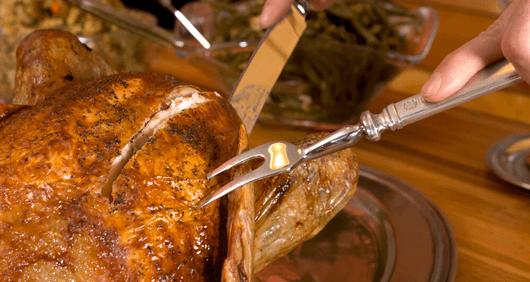Why It’s The Cut Of Your Mouthguard You Should Be Thankful For This Thanksgiving?

This Thursday is Thanksgiving, a time to give thanks and think about what matters most to us.
While there are many reasons to be thankful for your custom mouthguard, just like your turkey dinner this Thursday, none are more important than the cut or the cut style. After all, that’s what makes your mouthguard YOURS.
Remember, everyone’s mouth is different and in order to get the best proper protection when you are on the field, pitch, court or ice, your mouthguard must be cut to fit your exact mouth structure. That’s what distinguishes a custom mouthguard from generic stock or boil-and-bite mouthguards. (Well, that and complete personalization).
A custom mouthguard is cut to your specific needs; other mouthguards aren’t. It’s that simple.
So what exactly does that mean? Why should you be so thankful for the cut? First and foremost, it means the best protection possible. But a properly cut mouthguard does more than just protect against impact to the face or jaw.
The biggest and most frequent complaint that athletes have about their mouthguards is that they are bulky and uncomfortable, which restricts breathing and muddles speech. But that’s only because they are wearing the wrong mouthguards.
When a mouthguard is cut correctly, there isn’t any unnecessary or unwanted material in places it shouldn’t be. For example, your mouthguard shouldn’t have any material in the soft palate area — the fleshy, flexible part toward the back of the roof of the mouth. That means your mouthguard must end between the end of the first molar and midway through the second. Any protective material in the soft palate area doesn’t actually provide protection from injury; it only adds to the weight and discomfort of the mouthguard.
A proper cut also streamlines your mouthguard as much as possible, by adjusting the thickness in specific areas. It’s important to maintain proper thickness for protection, but anything beyond that could cause uncomfortable gagging.
Material that’s too thick also makes it difficult to open and close the mouth. Your mouthguard should fit snug against your upper teeth, without needing to bite or clench. All mouthguards should have at least 4mm of material in the important impact zones — the areas in front of the teeth and under the molars.
But this may actually vary from sport to sport, as some sports require more protection than others.
When your mouthguard is cut correctly — for you and for the particular sport you play — you are able to maximize both your comfort and protection.
This Thanksgiving, make sure you give thanks for the cut of your custom mouthguard. A properly cut mouthguard is what makes your mouthguard uniquely yours.




 This Thursday is Thanksgiving, a time to give thanks and think about what matters most to us.
This Thursday is Thanksgiving, a time to give thanks and think about what matters most to us. 

